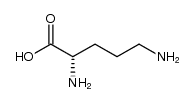聚 L-鸟氨酸氢溴酸盐

聚 L-鸟氨酸氢溴酸盐结构式

|
常用名 | 聚 L-鸟氨酸氢溴酸盐 | 英文名 | PPoly-L-ornithine hydrobromide |
|---|---|---|---|---|
| CAS号 | 27378-49-0 | 分子量 | 132.16100 | |
| 密度 | N/A | 沸点 | 333.3ºC at 760 mmHg | |
| 分子式 | (C5H12N2O2)x | 熔点 | N/A | |
| MSDS | 中文版 美版 | 闪点 | 155.4ºC |
|
Synthesis and characterization of alginate/poly-L-ornithine/alginate microcapsules for local immunosuppression.
J. Microencapsul. 283 , 840-848, (2008) Alginate/poly-L-ornithine/alginate (APA) coherent microencapsulation, which provides an immunoselective and highly biocompatible membrane, creates a viable option for cellular or tissue transplantation. This study explored the potential of incorporating immun... |
|
|
In vivo bioactivity of rhBMP-2 delivered with novel polyelectrolyte complexation shells assembled on an alginate microbead core template.
J. Control. Release 162(2) , 364-72, (2012) Electrostatic interactions between polycations and polyanions are being explored to fabricate polyelectrolyte complexes (PEC) that could entrap and regulate the release of a wide range of biomolecules. Here, we report the in vivo application of PEC shells fab... |
|
|
Improving alginate-poly-L-ornithine-alginate capsule biocompatibility through genipin crosslinking.
J. Biomed. Mater. Res. B. Appl. Biomater. 101(2) , 258-68, (2013) DIABECELL® capsules comprise an inner core of alginate (Alg) coated with a polycationic polymer, poly-L-ornithine (PLO), designed as a stabilizing agent for strengthening the capsule wall, which is masked by an outer layer of biocompatible Alg. These polymeri... |
|
|
Nonviral gene delivery in neural progenitors derived from human pluripotent stem cells.
Methods Mol. Biol. 767 , 343-54, (2011) Human pluripotent stem cells (hPSCs) have been used to derive self-renewing neural progenitor (NP) cell lines. Here we describe methods to genetically modify these cells. Detailed methods for transfection and nucleofection in PSC-derived NP cells are presente... |
|
|
[Programmed application of extracellular matrix promotes neural differentiation of mouse embryonic stem cells].
Nan Fang Yi Ke Da Xue Xue Bao 28(12) , 2126-30, (2008) To study the role of extracellular matrix (ECM) in neural differentiation of mouse embryonic stem cells (ESCs).Mouse ESCs were incubated in the ESC conditioned medium, and the formation of embryonic bodies (EBs) were induced in bacteriological dishes using hi... |
|
|
Nanofiber matrices promote the neuronal differentiation of human embryonic stem cell-derived neural precursors in vitro.
Tissue Eng. Part A 17(5-6) , 855-63, (2011) The potential of human embryonic stem (ES) cells as experimental therapies for neuronal replacement has recently received considerable attention. In view of the organization of the mature nervous system into distinct neural circuits, key challenges of such th... |
|
|
Chitosan enhances transfection efficiency of cationic polypeptides/DNA complexes.
Int. J. Pharm. 410(1-2) , 161-8, (2011) The aim of this research was to investigate the effect of cationic polypeptides mixed with chitosan (CS) on in vitro transfection efficiency and cytotoxicity in human cervical carcinoma cells (HeLa cells). The polypeptides/DNA complexes and ternary complexes ... |
|
|
Stability of alginate-polyornithine microcapsules is profoundly dependent on the site of transplantation.
J. Biomed. Mater. Res. A 81(1) , 1-11, (2007) Alginate encapsulation is a form of cell-based therapy with numerous preclinical successes but recalcitrant complications related to stability and reproducibility. Understanding how alginate stability varies across different transplant sites will help identif... |
|
|
A protocol for the differentiation of human embryonic stem cells into dopaminergic neurons using only chemically defined human additives: Studies in vitro and in vivo.
Brain Res. 1127(1) , 19-25, (2007) Our ability to use human embryonic stem (hES) cells in cell replacement therapy for Parkinson's disease depends on the discovery of ways to simply and reliably differentiate a dopaminergic (DA) phenotype in these cells. Although several protocols exist for th... |
|
|
Formulating the alginate-polyornithine biocapsule for prolonged stability: evaluation of composition and manufacturing technique.
J. Biomed. Mater. Res. A 83(1) , 216-24, (2007) Alginate encapsulation is one of the most widely used techniques for introducing cell-based therapeutics into the body. Numerous encapsulation methodologies exist, utilizing a variety of alginates, purification technologies, and unique polycationic membrane c... |